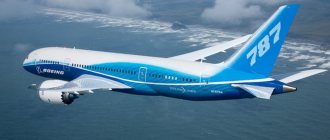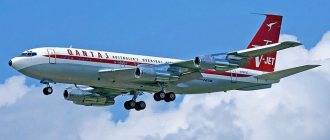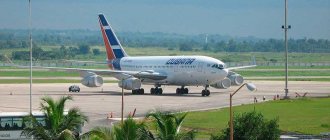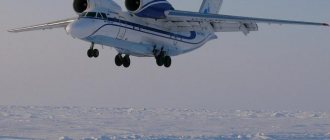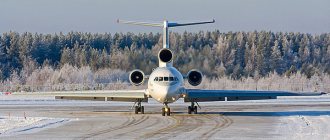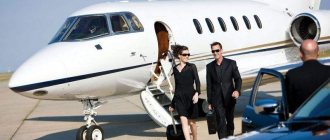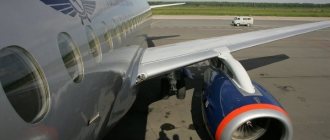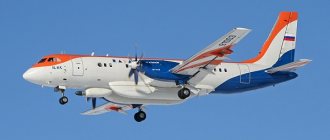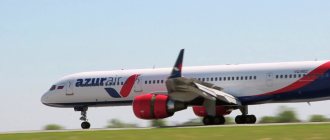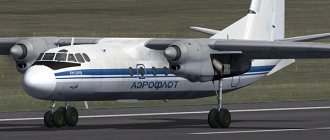Advantages
The success of the model is not surprising - fuel economy, more modern equipment, and most importantly, the ability to make long-distance flights.
An important factor was also the layout that was already familiar to pilots - hence saving costs on retraining. Passengers will also like the liner. Flight convenience, safety, non-stop flights and much more. It is not surprising that Boeing not only managed to fulfill all preliminary requests, but also did not release new models for a long time.
Dimensions
| Wingspan (m): | 47,57 |
| Length (m): | 48,51 |
| Height (m): | 15,85 |
After the war, Douglas and Lockheed actively developed their civil projects, introducing first the successful piston-powered DC-3 and Constellation, and then the DC-7C and L-1649 Starliner. Boeing Stratocruiser - a model that competed with them, but Boeing itself was focused on military orders - it produced tankers, bombers, etc.
Salon
The Boeing 767-200 took off before the development of transformable cabins. When ordering a plane, the airline had to specify which cabin option it wanted. Two or three classes. You could choose one class - it all depended on preferences.
First or business class
The comfort of the flight very often depends on the location of the seats on the plane, so when choosing a company you need to pay special attention to this. In this case, UTair does not make any special distinctions between passengers. All three aircraft have the same layout - one class from nose to tail. Economy
Representatives of the company do not comment on this, but experienced tourists already know Utair’s motto regarding these cars - less comfort, more passengers. The plane is very roomy, but not very comfortable.
Economy class
But even among places of the same type there are more or less comfortable ones. Therefore, when flying from UTair, you need to study the cabin layout before booking tickets. However, this applies to any company.
To view in high quality, click on the image.
The plane has 34 rows of eight seats each. Two seats by the window, aisle, four in the middle, aisle, and a couple more on the opposite side. Due to the design features of the Boeing 767-200, the number may vary, but such changes are few.
General information about the aircraft
This is a wide-body aircraft that is designed for long-distance routes . A photo of the Boeing 767-200 is presented below.
It began to be developed in 1978. In 1982, Boeing 767-200 became available to United Airlines. At first, it was used only by American companies on their domestic flights.
The interior layout assumed the presence of three classes with 181 seats or two classes with 224 seats. The total number of seats could have been increased to 290 , but then they should have been placed in a 2-4-2 pattern.
Boeing 767-200 UTair.
Subsequently, the Boeing 767-200ER model appeared with a different cabin layout.
Now most of these Boeings have been converted from passenger to cargo. Another 158 aircraft of this model are in service with various airlines.
Its maximum flight altitude is 13,140 m. The flight range is 12,200 km. Cruising speed - 850 km/h.
Choosing places
Before moving on to describing the interior layout, it’s worth deciding which places are the best or the worst. Most travelers adhere to the same standards. The best ones are those with the ability to recline, stretch your legs, and, preferably, without specific odors. The worst ones are the opposite.
The best
Based on these standards, we can name only 3 rows that meet all the listed requirements. This is the first row and rows in the middle of the cabin - 16 and 17. Since there are exits in front, passengers sitting here have the opportunity to stretch their legs or recline the backrest.
Having arranged these rows by rating, we get the following picture. The first row receives a bronze medal. Those sitting in the aisles at the very beginning of the journey may not be very comfortable. The majority of people enter through doors located slightly in front of the cabin. As they pass by, they may hit passengers in these seats. Those sitting in the middle of the central block or near the porthole do not have such problems.
The second place is occupied by the 17th row. Here the situation is the opposite - those sitting in the middle block have the opportunity to stretch their legs or lean back. The outer blocks do not have this opportunity. Why? This is a design feature of the Boeing 767-200. It is thanks to her that row No. 16 earns the palm. There are only 4 seats and there is no middle block of seats. There are emergency exits ahead - so all passengers sitting here will have the opportunity to recline or stretch their legs. An additional plus is that although the toilets are nearby, they are separated by an additional bulkhead, so those sitting here should not be bothered by odors.
Worst
Here, too, you can conduct a ranking, but there will be no bronze medalist in it. Two rows share the silver medal as not the worst. And one row will receive “gold”.
Silver goes to rows 13 and 33. Here legroom may not be enough, as there is still room in front. An additional inconvenience will be the rigidly fixed backrests - there are walls behind the toilets, there is simply nowhere to recline them. It will be a little easier in this row for passengers occupying two seats on the starboard side and the central block. This is another design feature of this Boeing.
The worst is the 34th row. It is incomplete, with only 5 beds, but surrounded by toilets. The lack of legroom, the backrest fixed in one position, smells and queues will become companions for passengers seated in this row.
Neutral
The remaining rows do not present any special differences. Passengers sitting here can recline their backs on the neighbors behind them. There is very little legroom.
History of the development of the Boeing 767 passenger aircraft
The first long-haul airliner in the history of civil aviation was created by designers of the American aircraft manufacturing corporation Boeing. It was a Boeing 747, also known as the Jumbo Jet or simply the 747, which first entered service in 1970.
The aircraft manufacturer initially wanted to make its next development a short-haul passenger aircraft, but changed its mind due to lack of demand from carriers, and set the engineers the task of designing a more advanced airliner intended for transcontinental flights.
The designers proposed several projects to the production workers, including a three-engine one with a T-shaped keel. Based on the technical parameters of the latest jet engines at that time and on economic feasibility, the corporation settled on a twin-engine single-fin airliner, which had a number of similarities with the Airbus A300.
In addition to state-of-the-art engines, improved aluminum alloys and composite materials were used in the manufacture of the new airliner, and structural improvements in aerodynamic properties were implemented during the design. This ensured a reduction in aircraft weight and fuel consumption, making it possible to painlessly increase the length of the fuselage and cabin capacity, thereby enabling airlines to sell more tickets.
Boeing 767 glass cockpit
An important technical innovation introduced in the Boeing 767 is the flight management system (FMS), which includes new cathode-ray displays instead of analog indicators. Thanks to FMS, the crew size was reduced to two pilots - without a navigator and flight engineer, although the latter was often included in the crew at first, and the cabin was made into a 3-seater. Later, such equipment, implemented for the first time, was called the “glass cockpit.”
Actual production of the new widebody design began in July 1978 at the aircraft manufacturer's plant in Everett, Washington. On September 26, 1981, the first test flight took place, which was successful, except for the leakage of hydraulic fluid from the landing gear retraction system.
Testing of the 767 continued for almost a year, after which in July 1982 the 767-200 model successfully passed certification by authorized authorities in the United States and Great Britain, and on August 19, United Airlines was the first to begin operating it.
The most popular model is the 767-300, certified in 1986, and continues to be used by air carriers today, despite a significant number of accidents involving Boeing. But Aeroflot took them out of service in 2014, and subsequently its subsidiary airline also abandoned them.
Marking of seats in 767-200 Utair
Knowing the location of seats on the plane, it is not difficult to order a specific seat. But there are 8 seats in a row - how to get what you want? The marking of seats in the cabin is regulated at the international level. It does not change from liner to liner, no matter what company the user chooses. UTair is an exception, so it should be considered separately.
The marking begins from the left side if you stand facing the cockpit. The window seat is A. The aisle seat is B. According to the rules, the third seat is C. But in 767 there is none. The next one, the first one in the central block, is D. On the right hand of him will sit the person who bought seat E. Since Utair has four seats in the block, the rest are marked as F and G. Seats L are located at the starboard windows. One seat not named on the right side of the second aisle is marked K.
Example
6A - 6th row, left side, window seat 17E? 17th row, one of the middle seats in the central block. 32K - located at the second passage, to the right of it. Row number - 32.
Description and technical characteristics
Compared to the 747 design, the 767's wing size and chord have been increased by more than 50%. It is made wide-body, which increases the width of the cabin by one and a half meters.
Main characteristics of the 767-300, the most common representative of the 767 family:
Length - 54.94 meters; Wingspan - 47.6 m; Fuselage width - 5.03 m; Weight - 86.07 tons; Passenger capacity - min 218, max 350 people; Cargo and luggage capacity - 106.8 cubic meters.
Two engines are suspended on the sides of the wing. The company used different models of motors - CF6-80A or CF6-80C2; Pratt & Whitney - PW4062; Rolls-Royce - RB211.
The tail of the liner is single-finned, the wing is swept. The 767 belongs to the low-wing aircraft, that is, to aircraft with one wing, which is located low relative to the fuselage.
Main Boeing 767 models
Boeing 767-200
The basic model of the 767 family was used mainly for long-haul domestic flights - transportation between the largest cities in the western and eastern parts of the United States (Los Angeles - New York, San Francisco - Washington, etc.). The manufacturer produced only 128 of these aircraft. They were discontinued in the late 1980s in favor of the improved 767-200ER. Later, on the basis of the passenger 767-200, the corporation created a vessel for transporting cargo 767-200SF.
Boeing 767-200ER
The 767-200ER variation is designed as a twin-engine airliner for transcontinental flights, as indicated by the abbreviation ER - extended range, in Russian - increased range. The first operator of the model was El Al Israel Airlines, which began use in 1984, two years after the base airliner.
Differences between this Boeing and the base model:
an added tank to increase the amount of fuel on board, which is necessary to increase the flight range without refueling; installation of more powerful motors.
Today, about 150 767-200ER aircraft remain in service, including former airliners converted into freighters.
Boeing 767-300
The development of the 767-300 involved lengthening the fuselage by 6.43 meters and increasing the overall length of the Boeing to almost 55 m. Subsequently, it began to be equipped with more powerful engines - RB211 from Rolls-Royce.
The first operator of the 767-300 is Japan Airlines. The manufacturer produced 104 of these aircraft. In the late 2000s, the corporation began producing a cargo version - the 767-300BCF.
Boeing 767-300ER of the German carrier Condor Airlines
Boeing 767-300ER
The Boeing 767 300ER is a variation of the 767-300 with an increased flight range, take-off weight and passenger capacity, which is why it has the greatest demand among air carriers among all models in the family. By 2010, more than 520 units had been produced.
It was the Boeing 767-300ER in 1989 that made the world's first flight that met the new ETOPS-180 standards, that is, lasting within 180 minutes of flight to the nearest airfield. The plane safely covered the distance from the US mainland to Honolulu, the capital of Hawaii, without refueling.
Boeing 767-300F
The aircraft with the letter F is a separate cargo variation, developed in the 1990s based on the 767-300ER, accommodating 24 standard pallets (2.2 x 3.2 meters) with cargo on the main deck and up to 30 LD2 containers on the lower deck. The first customer-operator is UPS Airlines.
